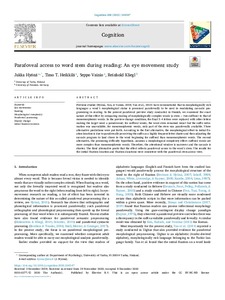Parafoveal access to word stem during reading: An eye movement study
Hyönä Jukka; Heikkilä Timo T.; Vainio Seppo; Kliegl Reinhold
https://urn.fi/URN:NBN:fi-fe2021042821807
Tiivistelmä
Previous studies (Hyönä, Yan, & Vainio, 2018; Yan et al., 2014) have
demonstrated that in morphologically rich languages a word's
morphological status is processed parafoveally to be used in modulating
saccadic programming in reading. In the present parafoveal preview study
conducted in Finnish, we examined the exact nature of this effect by
comparing reading of morphologically complex words (a stem + two
suffixes) to that of monomorphemic words. In the preview-change
condition, the final 3–4 letters were replaced with other letters making
the target word a pseudoword; for suffixed words, the word stem
remained intact but the suffix information was unavailable; for
monomorphemic words, only part of the stem was parafoveally available.
Three alternative predictions were put forth. According to the first
alternative, the morphological effect in initial fixation location is
due to parafoveally perceiving the suffix as a highly frequent letter
cluster and then adjusting the saccade program to land closer to the
word beginning for suffixed than monomorphemic words. The second
alternative, the processing difficulty hypothesis, assumes a
morphological complexity effect: suffixed words are more complex than
monomorphemic words. Therefore, the attentional window is narrower and
the saccade is shorter. The third alternative posits that the effect
reflects parafoveal access to the word's stem. The results for the
initial fixation location and fixation durations were consistent with
the parafoveal stem-access view.
Kokoelmat
- Rinnakkaistallenteet [27094]
